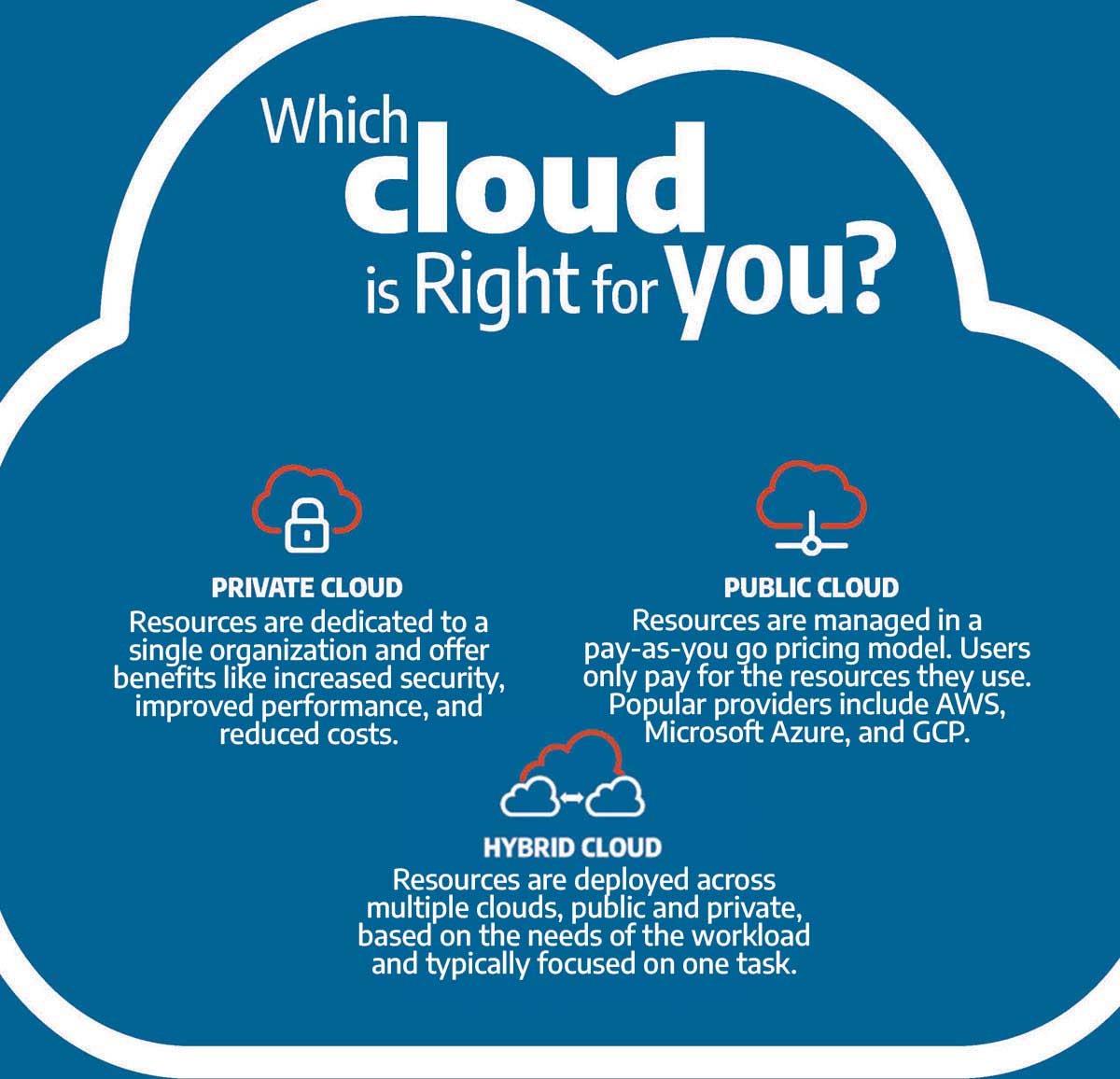Public vs Private vs Hybrid Cloud – Everything You Need to Know
Connectria
Author
Date
February 1, 2022

The statement that “cloud adoption is accelerating the world over” is no longer sufficient to detail the impact of cloud infrastructure. Within this inarguably accelerating adoption is segmentation and detail that must be understood to fully appreciate the role of the cloud. These nuances include not just the well-known public cloud, but also private cloud and hybrid-cloud infrastructure.
Painting all of the cloud with a broad brush overlooks these meaningful details. For example, Forbes cites the rising popularity of hybrid clouds for companies that are now comfortable with the cloud and looking to optimize their environments. Digging into these different cloud configurations gives context to the cloud itself.
There are many different types of clouds, but the three most common are public cloud, private cloud, and hybrid cloud. In this post, we’ll define each type of cloud and highlight the benefits and drawbacks of each. To start, it is important to understand what cloud hosting is in the first place. From there, an understanding of public, private, and hybrid clouds is simply a matter of recognizing some simple, yet meaningful, differences in how clouds are configured and connected.
Already have questions? Contact us for one-on-one expert help finding the right cloud solution for your business.
What is Cloud Hosting
Cloud hosting is the delivery of computing as a service rather than a product from a chosen hosting provider. The “cloud” describes the Internet or any network that enables access to software, data, infrastructure, and tools on demand. Users pay based on their actual usage rather than needing to buy an entire IT infrastructure they don’t need all at once. They can also scale up or down quickly without waiting for physical hardware to arrive.
Cloud hosting is used for a variety of applications and services, including:
- Backup and disaster recovery
- Big data analytics
- Data storage
- File sharing
- Mobile and web applications
Each cloud instance, or “deployment”, supports the same use cases above but does so in different ways. Connectria entered the Enterprise Hosting Market in 1998. As cloud hosting has evolved, so has Connectria. We support customers in their cloud hosting journey and continue to recognize opportunities in expanding markets and investing in new technology. We help businesses realize their cloud vision with end-to-end hosting and managed services, from traditional enterprise technology to public and private cloud environments. We’re also the largest IBM i cloud provider in North America.

Public Cloud
A public cloud is a type of cloud computing in which resources are made available to the general public by a provider. The public cloud model uses a pay-as-you-go pricing model. Users pay only for the resources they use. Amazon Web Services (AWS), Microsoft Azure, and Google Cloud Platform are the most well-known public cloud providers. IBM and Oracle both have public cloud offerings as well.
Public clouds have many key benefits including elasticity, low up-front costs, and ease of use. Perhaps the biggest benefit of using the public cloud is improved performance for applications. The public cloud provides users with near-infinite capacity with scalability on demand. It also requires less internal IT knowledge and expertise to deploy and maintain. This makes it easier for businesses to quickly get up and running.
However, public clouds also have some drawbacks. For example, they can be less secure than private clouds and can make it more difficult to keep sensitive information safe. Public cloud providers do not allow users to access data centers or physical servers. This limits the amount of control and customization available. Finally, the pay-for-use pricing model of the public cloud can be problematic. Costs can soar if traffic spikes, unnecessary instances are left on, or your environment isn’t properly monitored.
Benefits of Public Cloud Deployments
- Enhanced security and control
- Greater scalability and agility
- Improved performance and efficiency
- Increased flexibility and scalability
- Lower costs and faster time to market
Drawbacks of Public Cloud Deployments
- Compliance Requirements
- Lack of Control
- Limited Customization
- Potentially Higher Costs
- Security Concerns
TRiA, Connectria’s multi-cloud management platform, provides everything you need to optimize spend, manage performance, and ensure continuous security and compliance of your hybrid and multi-cloud architecture. We’re constantly adding new features to the platform and pride ourselves on our customer-driven product improvements.
Private Cloud
A private cloud is a type of cloud computing in which the resources are dedicated to a single organization. Private clouds offer a number of benefits, including increased security, improved performance, and reduced costs.
One of the key benefits of using a private cloud is increased security. Private clouds are more secure than public clouds because resources are dedicated to a single organization and not shared. Private clouds also offer improved performance and efficiency. This can lead to reduced costs and improved application performance. Additionally, private clouds can be custom-built to meet the specific needs of your organization. This allows you further control over who has access to data and how it is used.
Benefits of Private Cloud Deployments
- Increased security and compliance
- Improved performance
- More control over resources
- Reduced costs
Drawbacks of Private Cloud Deployments
- Less scalable than public cloud
- More expensive to maintain
Hybrid Cloud
Hybrid cloud is a combination of public and private clouds, providing businesses the best of both worlds. It allows you to deploy hybrid infrastructure with separate resources for public-facing systems, where scalability is important, and data that requires more control. The hybrid cloud can also be useful for applications requiring extensive customization or compliance restrictions.
With hybrid deployments, organizations don’t need to make a long-term infrastructure investment and can instead choose hybrid deployments as needed by different strategies or specific projects. While hybrid cloud can be more complex than other deployment models, hybrid cloud configurations are necessary in some cases to provide the best possible application performance. For example, hybrid cloud solutions may be required by regulatory agencies when sensitive information needs to be kept on-premises instead of in a public cloud environment. Therefore, it’s always important to check with your own internal compliance requirements before moving applications to the hybrid cloud.
Learn More About our Hybrid Architecture for IBM i & AIX Modernization
Hybrid Cloud Benefits
- Cost-effective at the start
- Flexible
- Improved security
- Reliable
Drawbacks of Hybrid Cloud Deployments
- Increased complexity and management overhead
- Increasingly expensive over time
- More complex security requirements
- Organizations must manage two different sets of hardware and software
Read our article What is Hybrid Cloud and Why Would I Need One?
Which is Right for You?
Public cloud services are scalable and offer high availability with resiliency through geographic redundancy at key points in the network. You must pay only for what you use (and not the number of resources you provision) with monthly pricing models like AWS spot instances where users can bid on unused resources.
Private cloud deployments require an organization to make a longer-term investment in hardware and software but provide improved performance compared to public cloud services because they’re located within the company’s data centers. Hybrid cloud deployments combine public and private cloud infrastructure, but this hybrid configuration introduces the added complexity of managing multiple sets of hardware and software systems for hybrid management.
The hybrid cloud is a good choice where certain applications need high scalability with optimal performance or extensive customization, as well as those that need to be compliant with regulations that require keeping some data on-premises rather than in the public cloud. The hybrid model can also provide lower costs because users can choose from both private and public clouds as needed by their particular strategy or application requirements. The ability to optimize different parts of infrastructure for performance, security, or cost makes hybrid cloud deployments increasingly popular.
Contact us today to start a conversation about finding the right cloud solution for your business.
Keep Reading
Prepare for the future
Tell us about your current environment and we’ll show you the best path forward.
Fast track your project. Give us a call.





